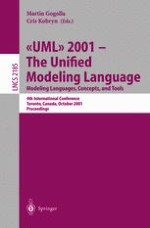2001 | Buch
≪UML≫ 2001 — The Unified Modeling Language. Modeling Languages, Concepts, and Tools
4th International Conference Toronto, Canada, October 1–5, 2001 Proceedings
herausgegeben von: Martin Gogolla, Cris Kobryn
Verlag: Springer Berlin Heidelberg
Buchreihe : Lecture Notes in Computer Science
Enthalten in: Professional Book Archive
